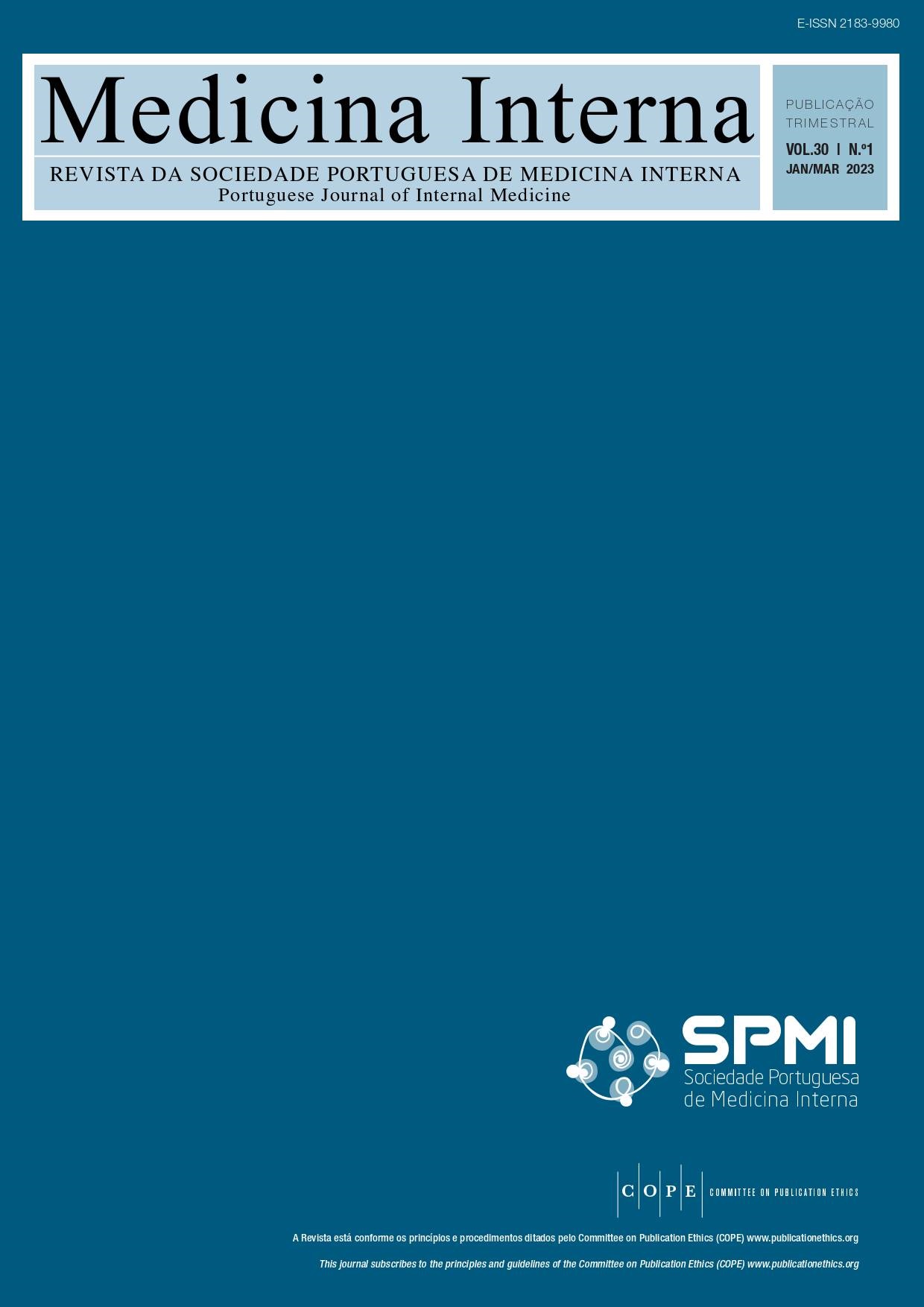A Prevalence of Dysphagia in Patients Admitted to a Department of Internal Medicine and Intensive and Intermediate Care Unit: Results of a Pilot Study.
DOI:
https://doi.org/10.24950/rspmi.929Keywords:
Deglutition Disorders/complications, Deglutition Disorders/epidemiology, Hospitalization, Internal MedicineAbstract
Introduction: Dysphagia is a frequent problem during the
course of life, but its prevalence in the population admitted to internal medicine services is unknown.
Material and Methods: We developed a prospective, single-centre study with the purpose of calculating the prevalence rate of dysphagia in an Internal Medicine service, identifying risk factors and characterizing its main complications.
Results: In a sample of 79 patients consecutively admitted over a 12-week period (54.4% male, mean age 74.2 years),
the prevalence of dysphagia was 34%, and 21.5% of patients
had moderate to severe dysphagia.
Conclusion: The presence of dysphagia was related to
gender, age, comorbidity index, functional status and presence of previous dysphagia in this sample. About one in six patients developed complications of dysphagia during hospitalization and their occurrence was related to the severity of dysphagia.
Downloads
References
Ferreira AM, Pierdevara L, Ventura IM, Gracias AM, Marques JM, Reis MG. Gugging Swallowing Screen: contributo para a validação cultural e linguística para o contexto português. Rev Enf Ref. 2018; 16: 85-94. doi.org/10.12707/RIV17090.
Malagelada, J, Bazzoli, F, Boeckxstaens, G, DeLooze, D, Fried M, Kahrilas, P, et al. Dysphagia. World Gastroenterology Organisation Global Guidelines, Update September 2014. [accessed in 2021 September]. Available at: https://www.worldgastroenterology.org/UserFiles/file/guidelines/dysphagia-english-2014.pdf
Altman KW, Yu GP, Schaefer SD. Consequence of dysphagia in the hospitalized patient: impact on prognosis and hospital resources. Arch Otolaryngol Head Neck Surg. 2010;136:784-9. doi: 10.1001/archoto.2010.129.
Padovani AR, Moraes DP, Sassi FC, Andrade CR. Clinical swallowing assessment in intensive care unit. Codas. 2013;25:1-7. doi: 10.1590/s2317-17822013000100002.
Clavé Civit P; García Peris P. Justificación y objetivos. In: Guía de diagnóstico y de tratamiento nutricional y reabilitador de la disfagia orofaríngea. Barcelona: Editorial Glosa: 2011. p. 13-7.
Charlson ME, Pompei P, Ales KL, MacKenzie CR. A new method of classifying prognostic comorbidity in longitudinal studies: development and validation. J Chronic Dis. 1987;40:373-83. doi: 10.1016/0021-9681(87)90171-8.
Health Care Transformation Task Force: Proactively identifying the high cost population, 2015 [accessed in 2021 September]. Available at: https://hcttf.org/wp-content/uploads/2018/01/WhitePaper ProactivelyIdentifyingtheHighCostPopulation.pdf
Mahoney FI; Barthel DW. Functional Evaluation: The Barthel Index. Md State Med J. 1965; 14:61-5.
Kondrup J, Rasmussen HH, Hamberg O, Stanga Z, Ad Hoc ESPEN Working Group. Nutritional risk screening (NRS 2002): a new method based on an analysis of controlled clinical trials. Clin Nutr. 2003; 22: 321-36. doi: 10.1016/s0261-5614(02)00214-5.
IBM Corp. IBM SPSS Statistics for Windows, Version 27.0. Armonk: IBM Corp:2020.
Spronk PE, Spronk LE, Lut J, Gnacke E, Mijnes D, Munster B, et al. Prevalence and characterization of dysphagia in hospitalized patients, Neurogastroenterol Motil. 2020; 32: e13763. doi: 10.1111/nmo.13763
Kertscher B, Speyer R, Fong E, Georgiou AM, Smith M. Prevalence of oropharyngeal dysphagia in the Netherlands: a telephone survey. Dysphagia. 2015; 30: 114-20. doi: 10.1007/s00455-014-9584-z
Bhattacharyya N. The prevalence of dysphagia among adults in the United States. Otolaryngol Head Neck Surg. 2014; 151:765-9. doi: 10.1177/0194599814549156.
Hayashi M, Yahiro A, Sakuragi Y, Iwamatsu K, Sakamoto H, Kaizuka Y, et al. Impaired swallowing in hospitalized patients. Nurs Res. 2016; 65: 389-96. doi: 10.1097/NNR.0000000000000178
Baijens LW, Clave P, Cras P, Ekberg O, Forster A, Kolb G, et al. European Society for swallowing disorders - European Union geriatric medicine society white paper: oropharyngeal dysphagia as a geriatric syndrome. Clin Interv Aging. 2016; 11:1403-28. doi: 10.2147/CIA.S107750
Downloads
Published
How to Cite
License
Copyright (c) 2023 Internal Medicine

This work is licensed under a Creative Commons Attribution 4.0 International License.
Copyright (c) 2023 Medicina Interna






